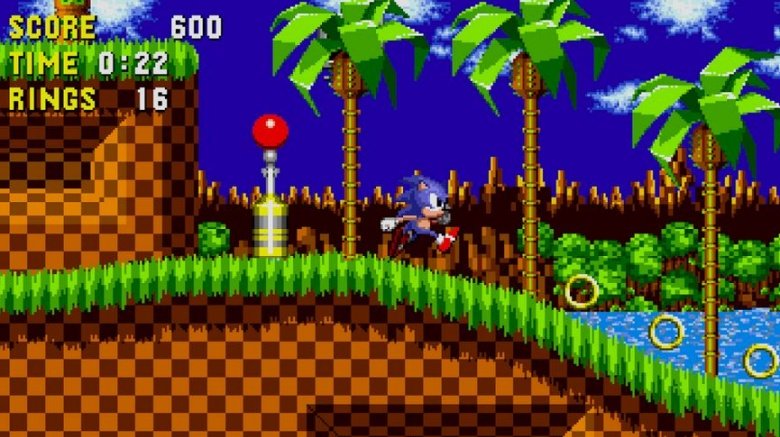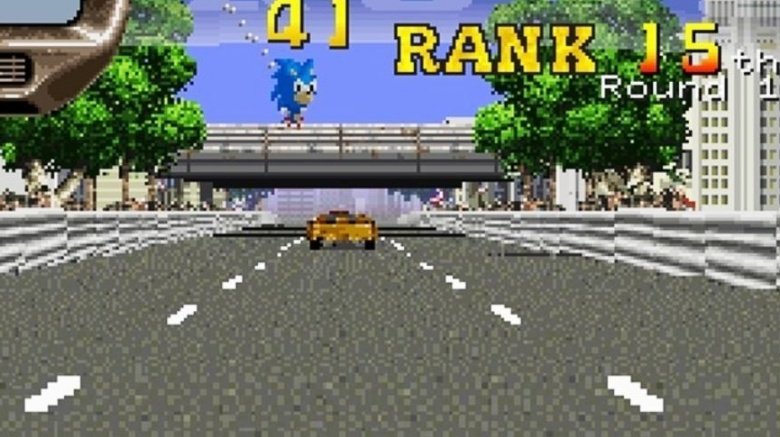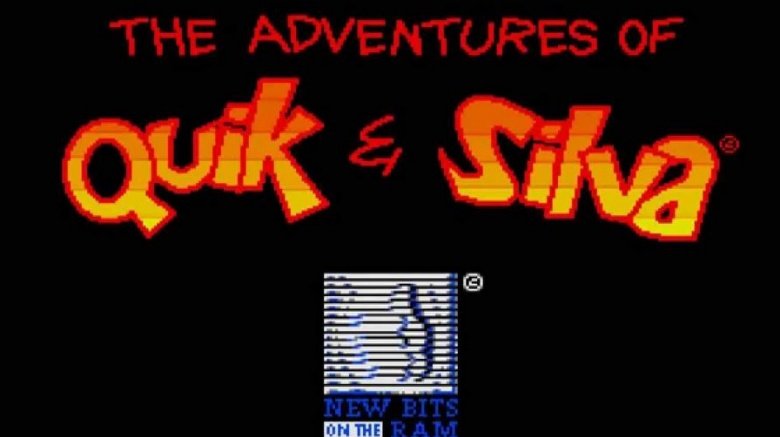Sonic The Hedgehog's First Home Game Appearance You Probably Missed
Most people assume that Sonic the Hedgehog made his home video game debut on June 23, 1991, when the game with his name in it–Sonic the Hedgehog–released for the Sega Genesis console. Most people, however, are wrong.
Months before Sega's speedy blue mascot officially made his way to living rooms across America, he made a cameo in an entirely different game. As discovered by YouTuber Larry Bundy Jr., Sonic's first real foray into home entertainment is a weird, unpolished, and borderline illegal project—and one that's been almost entirely forgotten as the years have passed.
A new mascot awaits
In the late '80s, Sega was in bad shape. While the Sega Genesis (known in Japan as the Mega Drive) hit stores in 1988–two years before Nintendo released its own 16-bit console–Sega lagged behind Nintendo in both sales and reputation. In Japan, the release of Super Mario Bros. 3 completely overshadowed the Mega Drive's launch, and Sega's current mascot, Alex Kidd, didn't resonate with audiences like Nintendo's portly plumber.
And so, Sega began searching for a new mascot—and an accompanying blockbuster franchise—to help the company gain a foothold in the competitive video game market. An internal Sega team known as AM8 started developing ideas, and one designer, Naoto Ohshima, came up with a blue, fanged hedgehog that he called Mr. Needlemouse. Unlike Mario, a middle-aged man who moved at a relatively languid pace, Mr. Needlemouse was quick and cool. He played guitar in a rock band. He had a human girlfriend named Madonna. Most crucially, both Mr. Needlemouse and his game moved really, really fast.
Sega executives liked Mr. Needlemouse, but decided that he was a little too edgy, even for the '90s. They pulled his fangs and kicked him out of the band. A redesign made him cuddlier and more appealing to an all-ages audience, while his new name, Sonic, better reflected the character's signature speed. Meanwhile, development on Sonic's first solo title began. Like Mario, Sonic leaped from platform to platform, collecting coins—or rings—while fighting enemies and scoring power-ups. Unlike Mario's, Sonic's world was full of curved surfaces and slopes, multi-tiered pathways, and an unrelenting pace.
A hint of things to come
Sega didn't just want Sonic to succeed–the company needed him to. Thankfully, as development on Sonic the Hedgehog continued, developers quickly realized that they had something special. Sega of America's head of marketing, Al Nilsen, travelled the country, conducting demonstrations that put Mario and Sonic head-to-head. Roughly 80 percent of players who participated preferred Sonic. Sonic stole the Consumer Electronics Show in summer 1991, while Sega made sure that Sonic graced the covers of as many video game magazines as possible in the months leading up to release. If you were into video games in '91, you couldn't escape Sonic. He was everywhere.
A few months before Sonic the Hedgehog's big debut, the character made his first video game appearance in Rad Mobile, a racing game produced by Sega's AM2 development group. It wasn't much more than a small cameo—a Sonic the Hedgehog air freshener hangs from the mirror above Rad Mobile's virtual dashboard—but as far as debuts go, it's not a bad one. Like Sonic, Rad Mobile is all about speed, putting players behind the wheel of a Ferrari 330 P4 and requiring them to outrace other cars, police officers, and built-in time limits.
But while Rad Mobile got a Sega Saturn port in 1994, in 1991 it was still an arcade-only release. In fact, Sonic's first foray onto home gaming devices didn't come from Sega at all, but a relatively unknown developer called New Bits on the RAM.
Factor 5's shady legacy
These days, you probably know Factor 5 as the company that helped make the Metroid-like action title Turrican a worldwide success, or as the developer behind the excellent Star Wars: Rogue Squadron arcade-style flight simulators. In the company's early days, however, it produced a number of games that shamelessly ripped off more successful titles. One of their first big games, Katakis, was such a blatant clone of Activision's R-Type that Activision gave Factor 5 an ultimatum: if the company didn't develop R-Type's official Amiga port, Activision would sue them into oblivion.
That's the climate in which Factor 5 established New Bits on the RAM, a subdivision devoted to making small, quick games on a limited budget and tight timeline. Unlike official Factor 5 releases, New Bits on the RAM's games weren't sold at retail. Instead, they were designed to be distributed in video game magazines. Back in the day, PC gaming mags didn't just come packed with previews, tips, and screenshots. Many also included floppy disks that contained a couple of free games.
Quik and Silva, New Bits on the RAM's first game, arrived with the June 1991 issue of Amiga Fun magazine (which actually hit newsstands in May, 1991). On the surface, The Adventures of Quik and Silva is a well-designed, budget platformer with eight stages and a toe-tapping soundtrack. Reviewers liked Quik and Silva quite a bit, praising the graphics and the "simple, wholesome gameplay." These days, Quik and Silva is less notable for its mechanics—which are fine—and more for one of its enemies, who has blue hair, spikes, and big, wide eyes. That's right: one of Quik and Silva's main villains is Sonic the Hedgehog, who appeared in the game more than a month before his official console debut.
Factor 5 beats Sega to the punch
Technically, Quik and Silva isn't a console game. It came out on the Commodore Amiga, which rose to fame as a home PC. As far as console releases go, Sonic the Hedgehog's legacy as the character's first home is secure. But the Amiga was a popular platform regardless—over the brand's lifetime, Commodore sold nearly five million Amiga systems. And if you're looking at all at-home game-playing devices, Sonic arrived on the Amiga first.
While Quik and Silva is a well-made game, it lacks a certain amount of polish. It's short, with only eight levels, two different themes, and only a few musical tracks. Its animation is simple, and its backgrounds uncomplicated. Larry Bundy Jr. alleges that New Bits on the RAM made Quik and Silva in about two weeks. Given Quik and Silva's quality, that's still pretty impressive, but it's also easy to see where New Bits on the RAM decided to take a couple of shortcuts.
For example, they decided to cut corners when coming up with enemy designs, "borrowing" them from other, better-known games—including the upcoming Sonic the Hedgehog. Given the timing, it's pretty clear what happened. New Bits on the RAM needed a bad guy, saw Sonic during Sega's multi-pronged marketing blast, and put him in Quik and Silva. That the game arrived before Sonic the Hedgehog is probably just a scheduling quirk, and not a deliberate attempt to undermine Sega's release. Still, for better or worse, New Bits on the RAM got there first. By the time that Sonic made his official debut, Quik and Silva was already out in the wild.
A lawsuit waiting to happen
It's not just Sonic who makes an unauthorized appearance in Quik and Silva. Almost every enemy is borrowed from another title. Bub, one of the two dragons from Bubble Bobble, appears as a short, hard-to-hit foe. Pogo, the hero of Nebulus, shows up as well. So does the power-up icon from Contra, the ship from R-Type, and characters from Factor 5's own Turrican. Even when New Bits on the RAM created its own characters, they borrowed from existing franchises. A cyborg foe looks an awful lot like a roboticized version of one of The Great Giana Sisters. One enemy is just Super Mario's head grafted onto a bouncing spring.
Even the developers' names during the end credits are knock-offs. As Bundy points out, Quik and Silva was programmed by Holger Schmidt, with graphics by Andreas Escher. And yet, Quik and Silva lists Andreas Breebruck as the lead coder (Andrew Braybook is the award-winning developer behind Paradroid, Fire and Ice, and Gribbly's Day Out). Markus Kohlman, the credited artist, is a play on Mark Coleman, the name of a prolific graphic designer. Among the three-man development team, only composer Chris Huelsbeck gets a real credit—and even then, his name is misspelled.
Where are they now?
While Quik and Silva might've featured Sonic's first appearance on a home device, it wasn't a well-known or popular game, and Sonic the Hedgehog quickly overshadowed it. When Sonic officially premiered in 1991, his game was an instant hit, sparking a franchise that's spawned over 70 games and sold more than 85 million units. Both Sonic and Sega have had their ups and downs over the years–as you probably know, Sega now makes software for other companies' consoles, including its long-time rival, Nintendo. But both are still going strong today, with 2017's Sonic Mania becoming the best-reviewed Sonic game of the past decade and a half.
New Bits on the RAM and Factor 5 weren't quite as lucky. The label only produced one other game, a gun-based platformer called Metal Law, before disappearing. Factor 5 became a legitimate game developer, thanks largely to Turrican and its collaborations with LucasArts, but its success didn't last. In 2007, Factor 5's PlayStation 3 exclusive Lair was panned by critics, largely because of the game's awkward control scheme. Factor 5 even sent out a guide post-release telling reviewers how to play the game. In 2009, Factor 5's American branch closed following the collapse of its publisher, Brash Games. Former employees subsequently filed a lawsuit, accusing the company of cooking the books in order to avoid paying wages.
Still, there's some hope: in 2017, Factor 5 co-founder Julian Eggbrecht revealed that he'd reacquired the rights to Turrican, and hinted that a Switch version might be on the way. It's been a while, but Factor 5 might be poised for a big return—let's just hope that they don't need Sonic's help to do it. Sega probably won't be as forgiving the second time.




